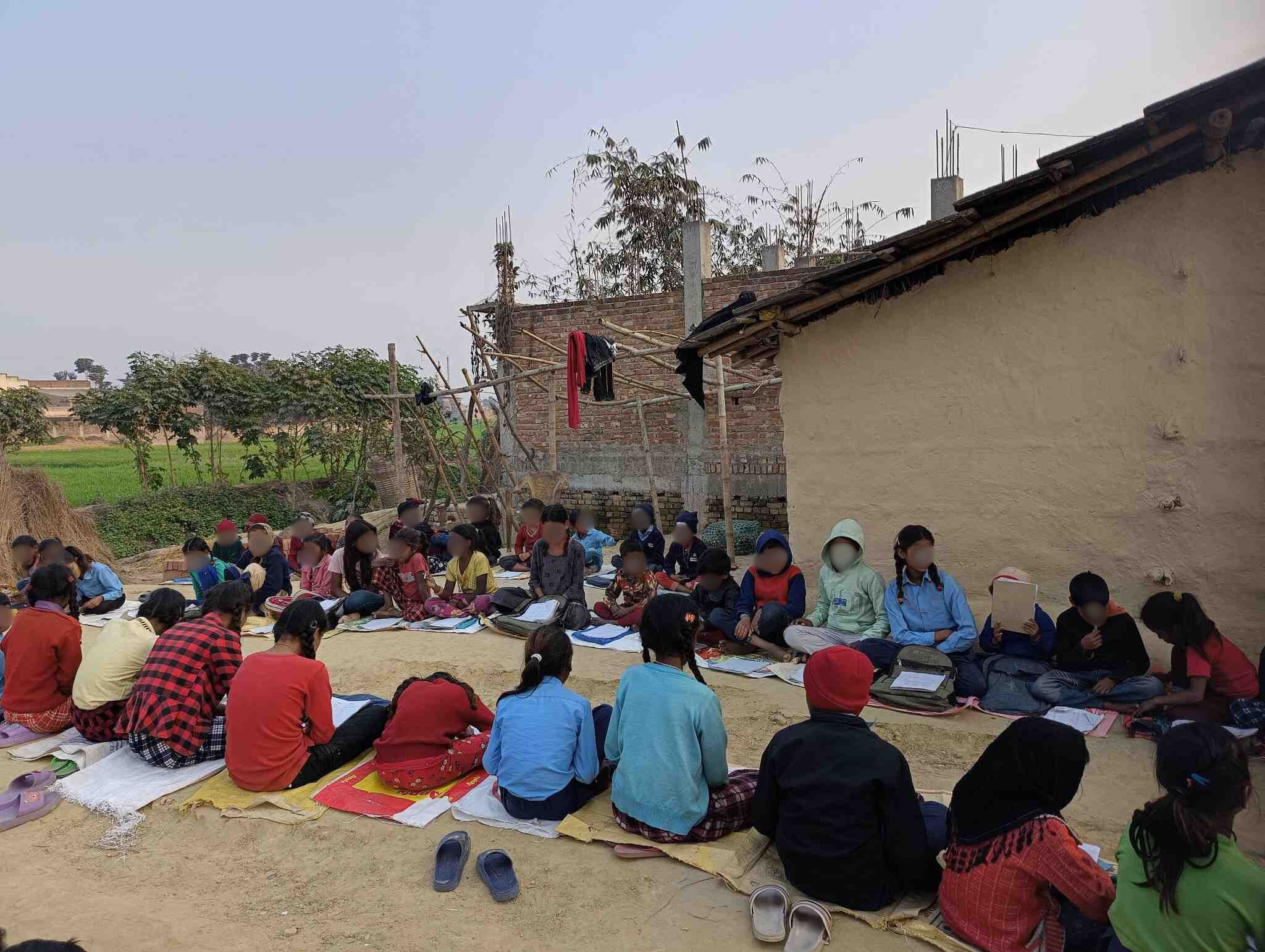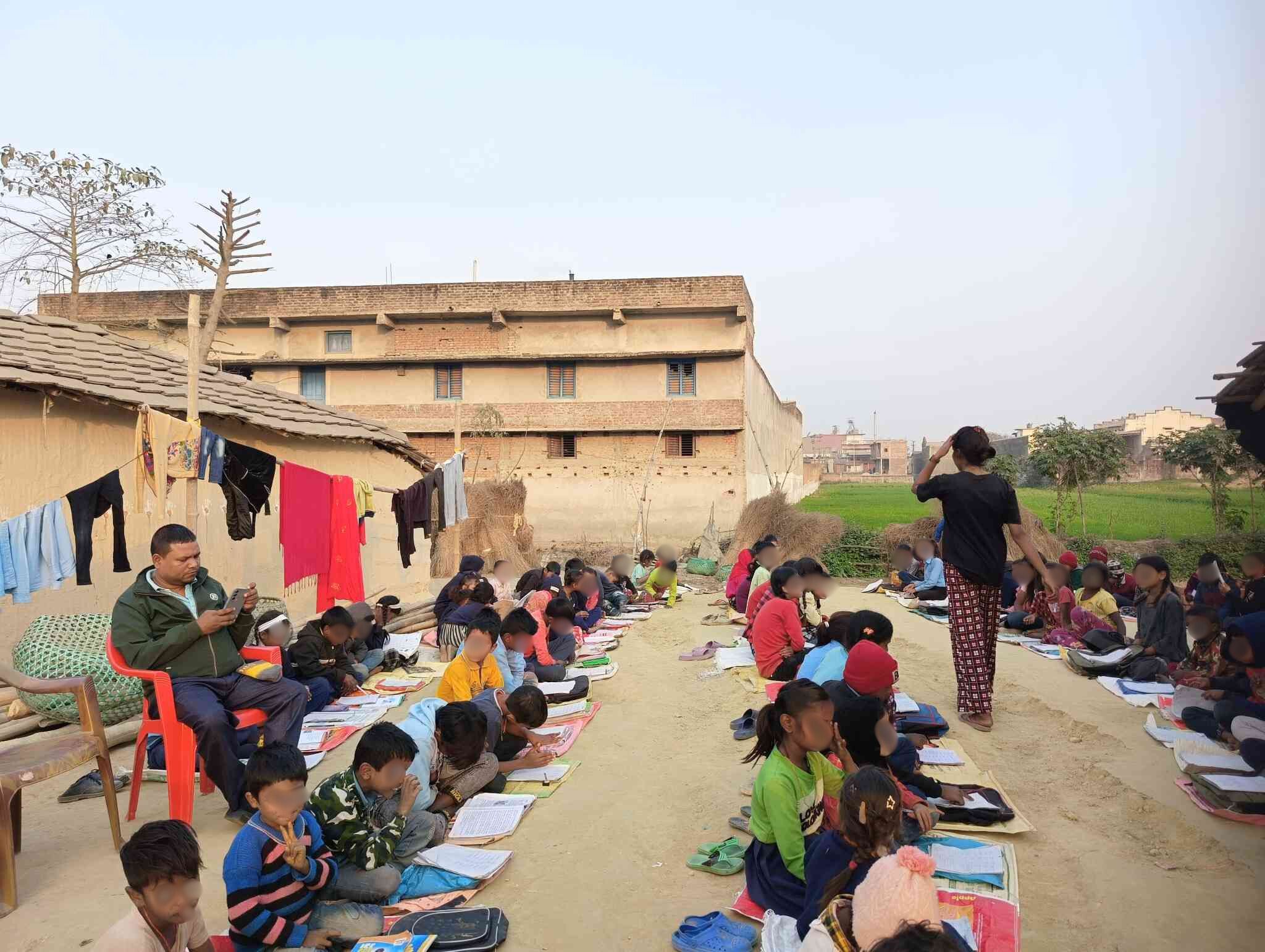Dalit child education | Marginalised community | Access to quality education | Parsa | Madhesi Dalit

The clock hit 4 PM. The calendar read February 14, Friday. I was at a Dalit settlement in Kehuniya, Bindawasini of Birgunj Metropolitan City ward number 19.
Children gathered at a vacant piece of land situated between two mud and bamboo huts to the north and the south. They are four to 14 years old and over 100 in numbers.
Some had backpacks and others held books, note copies and stationeries in hand. They sat on dusty ground, laying down sacks, to attend regular free community tuition classes to fulfill their school learning requirements.
There are three other such tuition classes in operation in Sakhuwa Parsauni Rural Municipality of Parsa district — Kataiya (Ward 3), Kauwaban (Ward 3) and Mahuwan (Ward 5).
All four community tuition centres operate under ‘Dalit Education and Community Dialogue Initiative’ by Peace4Dalits Foundation Nepal (P4D Nepal).
Around 4,000 Dalit children have attended classes across all four centres from fiscal year 2020/21 to 2023/24, says Manoj Ram, Dalit activist and president of P4D Nepal. It is the fifth batch in session and consists of another 1,000 children. They hire tutors to teach in the centres.
There’s a primary level public school a kilometre away from the locality — to be precise, opposite to Bindawasini Temple, within the metropolis’ jurisdiction.
Children who come to the Kehuniya centre are enrolled there, but don’t attend school. Their parents send them to graze cattles because they think it a source of income.
Children who should be pursuing higher levels discontinue school after Grade 8 or 9 (at approx. age 14-15) instead take up daily wage and physical labour jobs.
I chatted with Manoj on contemporary and historical reasons why Dalit children remain out of schools and even primary education being much inaccessible, let alone higher grades.
He revealed concerning inference, which round generational discrimination Dalits have been facing for centuries, inflicting poorest status in current socioeconomic order.
Manoj begins with what led to the present situation of Dalits in education—
School drop out is a cultured norm for children of Dalit community. For instance, if 50 children are enrolled in Grade 1, by the time the batch reaches Grade 5, the number of children reduces to 10. And only one or two take Grade 10 board exams, where they mostly fail.
Poor financial conditions, parents lacking awareness while equally ignorant in sending their children to schools, and local government’s ignorance are explicit reasons behind the norm.
The lack of awareness, and ignorance among parents come from historical oppression committed against Dalits — reducing their birth, existence and work to the lowest in the social order.
Our community was deprived of education and subjected to discrimination and marginalisation. Untouchability was prevalent in schools. It still is in rural settings. While explicit incidents of untouchability in schools have subsided over the time, the perspective of teachers towards Dalit children has not changed much.
Teachers derogatorily use terms like ‘chamar ko [bachcha]’, ‘dom ko [bachcha]’, ‘musahar ko [bachcha]’, ‘dalit ko [bachcha]’.” This spurs psychological harm to children.
The historically perpetuated discrimination is also one of the reasons for poor standing of Dalits in the economy. Our ancestors were forced to do menial jobs or were molded as workforce for menial works into the economy.
The present situation is a consequence of generational exclusion of Dalits from education, which has shaped a perception that remains so imprinted in our community that parents lack awareness of the long-run benefits of providing education to their children.
On constraints of continuing school and higher education, ignorance of local governments—
Nothing will change providing only primary education to children. If they are in school, they must at least complete Grade 10 boards and even bachelors for that matter to gain contemporary skills to earn a better livelihood. However, parents enrol their children only after social activists and organisations pressure them, yet they remain uncertain about the resources needed to ensure continuity.
As children grow and graduate to upper grades, their personal and schooling needs increase, adding strain on parents’ pockets. The federal government provides only NRs 400 a year to Dalit children in schools. The amount is meagre — as it can’t cover basic schooling expenses like uniforms, note copies, stationeries, a pair of shoes or even a bag. A bag alone costs at least NRs 600.

Parents who do daily wage labour jobs at construction sites, farms, etc. cannot afford these necessities, eventually withdrawing children from school. While those who continue do not excel because of the imprinted perception, and social and family environment.
For instance, parents come home tired, finishing their physical labour work for the day, so they need rest. They neither know much about education, nor can keep track of what their children studied or did at school. Most children fail their exams because we lack a supportive learning environment in our community and families.
Local governments with jurisdiction over schools ignore such needs of Dalit children. That’s why we had to step up and arrange free tuition classes to fill the learning gap. We spend yearly NRs 100,000 collected as donations from various individuals, including non-resident Nepalis (NRNs). Donors also provide note copies and stationeries. Sometimes, monetary donations are delayed up to a year. In such cases, we operate on credit. When it gets really hard, P4D Nepal bears the cost.
Nevertheless, if the local government shows will, they can easily do it. For a rural municipality consisting of around six wards, it will cost up to NRs 600,000. Not a big amount for them. [It should even be easier for a metropolis with a bigger budget and more resources to mobilise.]
If you talk about Parsa district, I think about 10,000 Dalit children are out of school. There are 14 local levels in the district. At least 500 Dalit children in each local level are out of school.
Our [community’s] perception and environment [regarding education] have been deformed and institutionalised for centuries, which is impacting us now. We need to invest [in education] to rectify [the historical injustice] and improve the present for a better future.
Formal education is one of the basic human needs. It’s the job of local government (read, the state) to ensure Dalit children’s access to quality education— at par to so-called “upper caste” and “upper class” privileged non-Dalits.
“As an educated person, I felt responsible for my community,” said Manoj, 32, who began his efforts to get his community improved access to education and healthcare at 16.
It was five years ago, when he along with Dalit activists and youths organised their efforts under Peace4Dalits Foundation Nepal, or P4D Nepal.
According to Manoj, they are currently helping 1,000 students with free tuition classes and providing them with note copies, stationeries, warm clothes, etc. By the end of 2025, they aim to reach 5,000 children.
“There are also places where there’s no need for such tuition centres but children lack learning materials, or drop out. We aim to ease their schooling by providing these materials and helping them rejoin school.”
P4D Nepal also organises awareness programs about social justice and ending caste untouchability.
There are other structural and social problems marginalising Dalits, particularly Madhesi Dalits living across Terai-Madhes. Alongside casteism that require socio-political resolution are lack of land ownership and citizenship certificates.
The Kehuniya’s Dalit settlement consisting of about 300 households, except for a few, live in mud huts (and under corrugated metal roofs) on pieces of land that they do not own. They do have land survey records in their names but not ownership, posing displacement threats.
Dipendra Kumar Ram in his near mid-20s is married and a father, whose child attends the tuition centre.
Dipendra serves as general secretary of P4D Nepal. He told me early marriage is common in their community — even before the legal age of 20 in some cases — thus begetting a child at an early age. According to him, there are a few adults without citizenship certificates in the locality.
Building on his insights, lack of citizenship certificates not only affects adults, but also their children’s prospects of school admission. Birth registration certificate is mandatory for admission and for that both the parents must have their citizenship certificates as well as marriage registration.
In cases where both the parents have their citizenship cards but it’s early marriage, authorities deny marriage registration. Meanwhile, if they beget a child, the registration process for a birth certificate is difficult as parents fail to prove the legal status of their marriage while the child ages.
Lack of citizenship certificates results in exclusion from economic, political and social opportunities, thus inflicting marginalisation on immediate generations to come.
Read More Stories
Kathmandu’s decay: From glorious past to ominous future
Kathmandu: The legend and the legacy Legend about Kathmandus evolution holds that the...
Kathmandu - A crumbling valley!
Valleys and cities should be young, vibrant, inspiring and full of hopes with...
Nepal to receive $36.1 million to mitigate GLOF risks
Nepal is set to receive $36.1 million in mitigating one of the escalated...